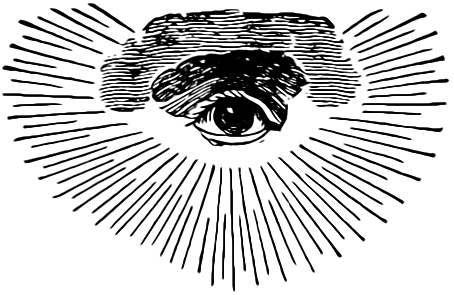Eye of Providence
From Wikipedia, the free encyclopedia

The Eye of Providence, or the all-seeing eye, is a symbol showing an eye surrounded by rays of light or a glory and usually enclosed by a triangle. It is sometimes interpreted as representing the eye of God keeping watch on humankind (see Divine Providence).
Contents |
[edit] Religious use of the Eye
Imagery of an all-seeing eye can be traced back to Egyptian mythology and the Eye of Horus. It also appears in Buddhism, where Buddha is also regularly referred to as the "Eye of the World" throughout Buddhist scriptures (e.g. Mahaparinibbana Sutta) and is represented as a trinity in the shape of a triangle known as the Tiratna, or Triple Gem.
In Medieval and Renaissance European iconography, the Eye (often with the addition of an enclosing triangle) was an explicit image of the Christian Trinity. Seventeenth-century depictions of the Eye of Providence sometimes show it surrounded by clouds or sun bursts.
|
Eye of Horus, son of the chief deity of the ancient Egyptians [1] |
An alchemical woodcut showing the all-seeing eye of God floating in the sky |
A 1525 Jacopo Pontormo painting using the Eye of Providence in a triangle as a symbol of the Christian Trinity |
|
|
An all-seeing eye that appears on the tower of Aachen Cathedral |
An all-seeing eye that appears on the pedestal decorations of Alexander Column |
An all-seeing eye that appears on the top of Declaration of Human Rights (1789), French Revolution |
An all-seeing eye that appears in a triangle at the facade of an Esoteric Christian Temple (1920), Mount Ecclesia |
[edit] United States
In 1782, the Eye of Providence was adopted as part of the symbolism on the reverse side of the Great Seal of the United States. It was first suggested as an element of the Great Seal by the first of three design committees in 1776 and is thought to be the suggestion of the artistic consultant, Pierre Eugene du Simitiere.[2]
On the seal, the Eye is surrounded by the words Annuit Cœptis, meaning "He approves (or has approved) [our] undertakings", and Novus Ordo Seclorum, meaning "New Order of the Ages". The Eye is positioned above an unfinished pyramid with thirteen steps, representing the original thirteen states and the future growth of the country. The lowest level of the pyramid shows the year 1776 in Roman numerals. The combined implication is that the Eye, or God, favors the prosperity of the United States.
Perhaps due to its use in the design of the Great Seal, the Eye has made its way into other American seals and logos, notably the Seal of Colorado and DARPA's Information Awareness Office.
[edit] Freemasonry

Today, the Eye of Providence is usually associated with Freemasonry. The Eye first appeared as part of the iconography of the Freemasons in 1797, with the publication of Thomas Smith Webb's Freemasons Monitor.[3] Here, it represents the all-seeing eye of God and is a reminder that a Mason's thoughts and deeds are always observed by God (who is referred to in Masonry as the Grand Architect of the Universe). Typically, the Masonic Eye of Providence has a semi-circular glory below the eye—often the lowest rays extend farther down. Sometimes the Eye is enclosed by a triangle.
Popular among conspiracy theorists is the claim that the Eye of Providence shown atop an unfinished pyramid on the Great Seal of the United States indicates the influence of Freemasonry in the founding of the United States. This was dramatised in the 2004 Disney film National Treasure. However, the first Masonic use of the Eye dates to 14 years after the creation of the Great Seal, and the Masonic version does not incorporate a pyramid, although the enclosing triangle is often interpreted as one. Furthermore, among the three members of the original design committee for the Great Seal (or any of the ones that followed it), only Benjamin Franklin was a Mason. Indeed, many Masonic organizations have explicitly denied any connection to the creation of the Seal.[4][5]
[edit] Other selected uses of the symbol
- Declaration of the Rights of Man and of the Citizen, the official depiction of which also borrows iconography of the Ten Commandments
- In The Lord of the Rings, Sauron is described as having an all-seeing eye. In the Rankin-Bass animated The Return of the King, the insignia for Sauron's troops closely resembled a stylized Eye of Horus. In the Peter Jackson trilogy, Sauron himself is physically manifested as an eye.
- The episode Omnivore of Criminal Minds featured a serial killer who uses the Eye of Providence as a signature.
- A symbol on the Salt Lake City Temple of The Church of Jesus Christ of Latter-day Saints
[edit] Currency


- The 50 Estonian Kroon
- The 500 Ukrainian hryvnia
[edit] Seals and logos
- The former logo of MI5, a British intelligence service
- The logo of the Information Awareness Office, a division of DARPA within the United States Department of Defense
- The Steve Jackson Games logo
- Several college fraternities use the Eye of Providence in their coats of arms and/or badges, notably Delta Tau Delta, Phi Kappa Psi, Phi Delta Theta and Delta Kappa Epsilon.
[edit] References
- ^ Wörterbuch der ägyptischen Sprache 1, 268.13
- ^ The Great Seal of the United States booklet, published by US Dept. of State
- ^ Masonic Service Association webpage on the Eye in the Pyramid
- ^ Grand Lodge of British Columbia and Yukon, Anti-masonry Frequently Asked Questions
- ^ Pietre-Stones Review of Freemasonry, The "Masonic" One Dollar: Fact or Fiction? by W.Bro. David Barrett
[edit] External links
| Wikimedia Commons has media related to: Eye of Providence |










